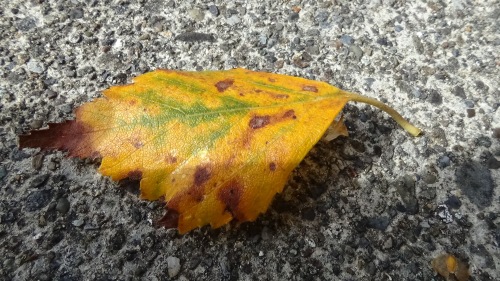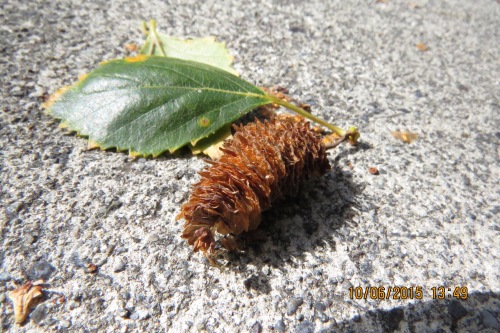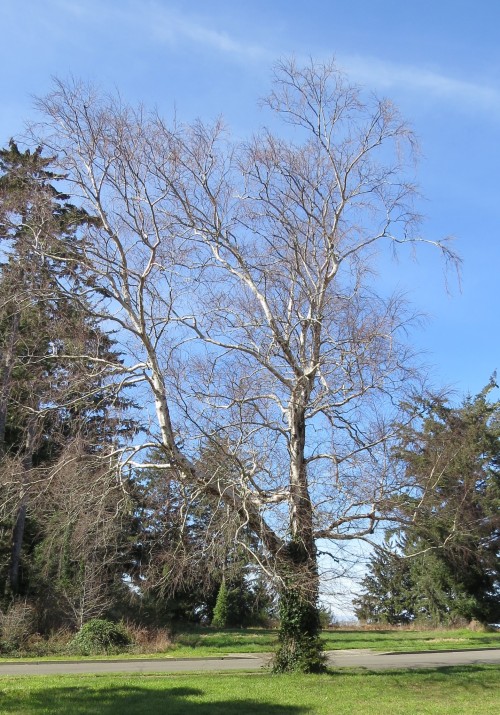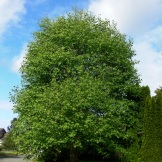River Birch or Himalayan Birch???

8-4-15…A look at the Birch, while the sun is out.
I was happy to meet Ollie who happened to be walking her dog at the same time. I explained that I was ‘following’ this tree, but was still unsure as to which species it was. She said that she was the one who had trimmed the ivy off the tree. “I know it’s a birch,” she says, “try looking up Himalayan birch” (betula utilis Jacquemontii)
I looked it up, but the Himalayan birch leaf is squarer at the base, not so wedge-shaped.

This is a Himalayan birch leaf. Note the rounded base of leaf…clearly not the same as a River birch. This image is courtesy of Oregon State University.

Here is another Himalayan leaf furnished by oregonstate.edu.
The leaf is tapered similar to the River Birch. How am I supposed to know the difference???

August 13…I picked another leaf off this morning to get another look at it.
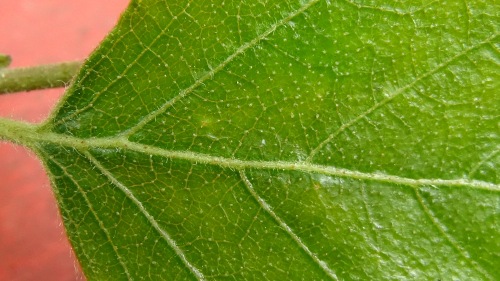
Aug. 13…I shot this close up with a new camera. This is just to see how well the zoomed close up option works and get a good close up look.
According to Washington State University, “Himalayan birch is the most widely grown of the birch species in the Pacific Northwest and is greatly prized for its distinctive white bark which makes it a welcome addition during the darker days of winter.“
Logically, since the Himalayan birch is more prevalent in the Pacific Northwest, it follows that this is a Himalayan birch…but of all the Himalayan leaves that are shown on Google images, most of them are “square” at the base, and while the River Birch is native to the southeastern United States, it is tolerant in other climates too as long as it can grow in moist acidic soils. Since it was planted possibly over 40 years ago, this area was getting about 65 inches of rain a year then. It would have been moist enough for a River Birch. That’s my story and I’m sticking to it. 🙂
Speaking of leaves…

I think the leaves are starting to turn already. We’ve been having many days of sunny weather.

August 4…example of a leaf that has lost it’s chlorophyll. Chlorophyll gives leaves their green color and absorbs light that is used in photosynthesis. You have to wonder why some leaves lose color while others don’t. “Okay everyone on this list gets no more chlorophyll.” I’m sure there’s a good reason, but this leaf here must be on the list. 🙂 Eventually, because of shorter days and decreasing sunlight, the tree will stop producing chlorophyll altogether and all the leaves will turn color.

Cinnamon bark is a-peeling.

An even closer look at the peeling bark.

8-4-15…Uh oh, holes in the trunk…Is this the result of the dreaded Bronze Birch Borer? Not to worry, the River Birch is resistant to it, whereas it can severely damage a Himalayan Birch.

Some birch cones are ‘maturing.’ This one fell apart in my hand. Next month I’ll take one home and try to find the seeds.
According to SF Gate, “River birch also is valuable as a source of erosion control and is used to reclaim areas with high soil acid caused by mining. Wildlife, such as birds and rodents, eat its seeds, and deer eat its twigs and foliage. Ruby-throated hummingbirds drink its sap.”
Any birch tree experts out there?
Read Full Post »


